Australian Six pence types
The sixpences of the entire pre-decimal era share common reverse designed by
W. H. J. Blakemore although there were three different master dies used.
The series commenced in 1910 with a single year of issue bearing the effigy of
Edward VII. The obverse design was by George W. de Saules.
King Edward VII died in May 1910 and was succeeded by George V. Australian sixpences
bearing George V's effigy were minted in London, Melbourne and Sydney during the
years 1911 to 1936. There are no obverse die varieties reported for any of the sixpences
of that period, suggesting that there was a single master die for the entire George
V series. The obverse design was by Sir Edgar B. Mackennal.
Writing in A New History of the Royal Mint,
Peter Gaspar & P.G. Dyer note that Mackennal was a sculptor, not an engraver,
and the design he produced was "technically unsuitable for coining" and
left the mint "in difficulty for a generation". Simple inspection of high-grade
coins suggests the reasons for this assertion. The bust had a high profile and required
high striking pressures so dies tended to wear quickly. Also, the design projected
above the rim of the coin(s) and so the coins themselves wore quickly.
Looking at the sixpences and three pences it seems that the mints tried a few
things to ameliorate the problems. The most obvious and frequent tactic seems to
have been to reduce the striking pressure somewhat. This yielded coins lacking in
definition, so-called "flat strike" coins, particularly noticeable in
the three pences where the star above the shield rarely shows the sharp ridges evident
in a perfectly-struck coin.
Another device which I have not seen mentioned in any numismatic literature seems
to have been to use a convex obverse die (and correspondingly concave reverse die),
producing a coins in a shallow dish shape. I have noted this on early coins such
as a 1911 sixpence minted in London, and on 1934 threepences from Melbourne. It
seems to have been particularly common on the early Melbourne sixpences of 1920-22.
The extraordinary result of this was to create coins whose wear pattern is contrary
to the norm for George V coins in that the reverse degraded more quickly than the
obverse. The mints succeeded in protecting the King's effigy at the expense of the
Arms of Australia and such coins can show significant wear on the kangaroo and emu
whilst retaining "8-pearl" obverses.
With the death of George V in 1936 the crown passed to his elder son, Edward
VIII but he abdicated before any Australian coins were struck bearing his likeness.
His younger brother assumed the throne as George VI.
The left-facing portrait of George VI is depicted on an obverse designed by Thomas
Paget. The Australian Government intended that the reverse design for the sixpence
be changed in 1938 along with those for other Commonwealth coins but according to
correspondence between the Australian High Commission and the Royal Mint, designs
for the sixpence and halfpenny were not settled by the beginning of 1938.
A later
letter dated 13/4/1938 described the new sixpenny reverse:
The same coat of arms design as on florin, but with these alterations. Emu to
be slightly smaller in relation to the kangaroo. Crown to be relatively smaller
in relation to whole design, and wattle to be eliminated. States emblems on shield
to be replaced by small stars. The word "sixpence" at the top and stars
now flanking the word "florin" to be eliminated.
Possible new 6d reverse
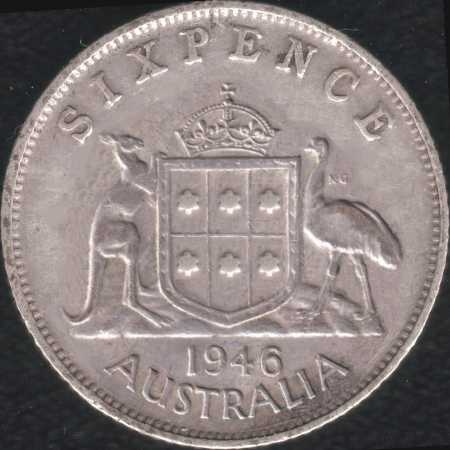
If the instructions given to the Royal Mint on 13th April 1938 with respect to the sixpence reverse had been followed then Australia may have had coins which looked something like this
Prolonged delays in the decision-making process which led to the late changeover
of the halfpenny design caused the plans for the sixpenny changeover to be abandoned.
With George VI's death, his eldest daughter, Elizabeth, became Queen in 1953.
The obverse design for subsequent sixpences was by Mary Gillick and depicted Elizabeth
II facing to the right and continued in use until the cessation of minting in 1963.
As mentioned above, whereas most Australian coins underwent significant design
changes in the period 1937 to 1939, the sixpences are unique in that the reverse
design persisted throughout the entire series. Given that consistency I was very
surprised to learn by examining the coins in my own collection that there were apparently
three master dies used (see illustrations below). There is probably some mention
of this in the numismatic literature but I have not seen it. In any case, there
is the possibility that there are master die pairing varieties yet to be discovered.
There is an entry in the Sydney die account book documenting the receipt on 17/5/1923
of twelve "new pattern" reverse sixpenny working dies (from Melbourne).
There is also an entry dated 30/4/1923 in the Melbourne book for the production
of those twelve dies from a new master punch provided by the Royal Mint in London.
According to the Sydney records, there were seven "old pattern" reverse
dies in stock at end of June 1923 and these remained in stock until their destruction
on 15/1/1924. Sydney minted all the 1922 coins and the bulk of the 1923 coins. It
seems likely that there was no "old pattern" (1921) reverse bearing the
1923 date and that all 1923 sixpences were struck with the "new pattern"
reverse.
Obverse designs
Obverse 1 - 1910
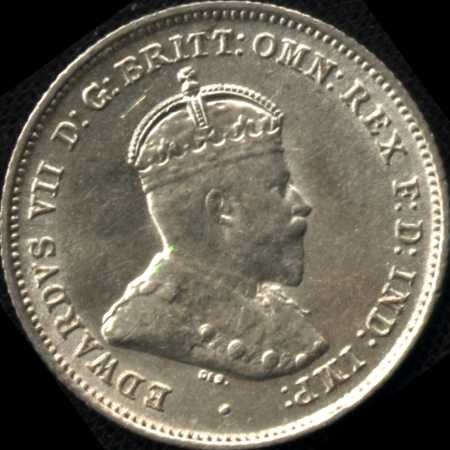
Obverse 2 - 1911-1936
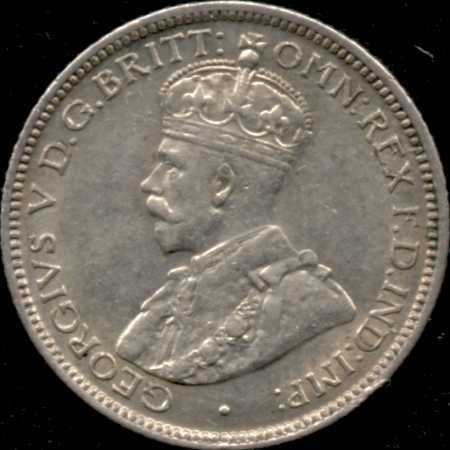
Obverse 3 - 1938-1948
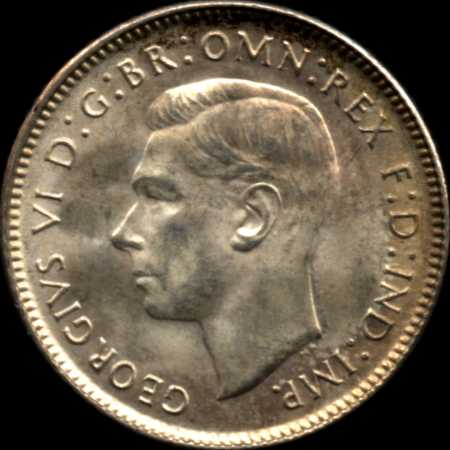
First of the George VI obverses. 130 rim denticles.
Obverse 4 - 1950-1952
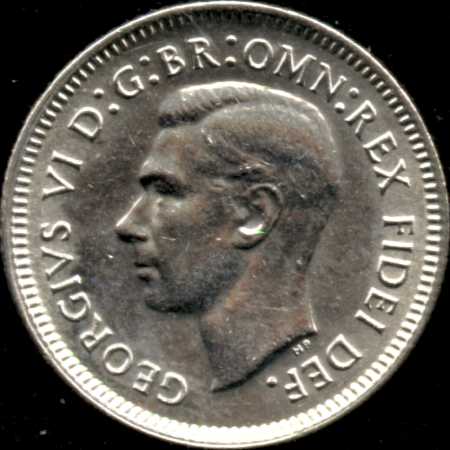
Second of the George VI obverses. IND IMP was eliminated from the legend, (necessary because India had become a republic shortly after becoming independent in 1947) and F.D. was expanded to FIDEI DEF. 128 elongated rim denticles.
Obverse 5 - 1953-1954
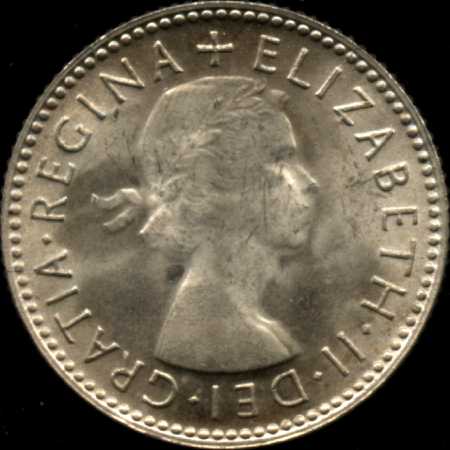
Obverse used for early Elizabeth II sixpences. The rim embellishment was changed from denticles to discrete round beads of which there are 94.
Obverse 6 - 1955-1963
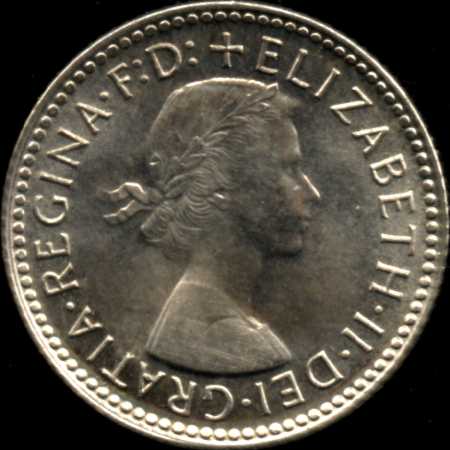
Obverse used for the later Elizabeth II sixpences. F.D. restored to legend. 94 rim beads.
Reverse designs
Reverse A - 1910-1922
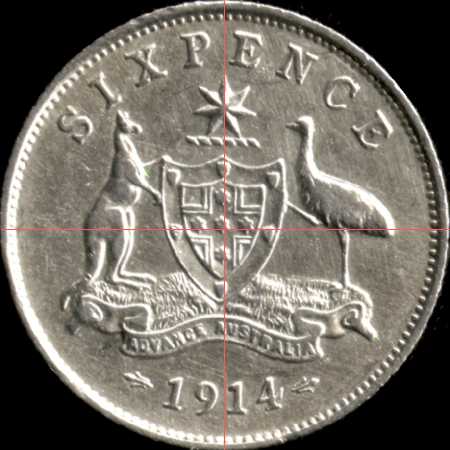
140 rim denticles. Gap over star. Main design skewed slightly to the left of
centre just as for the florins.
Reverse B - 1923-1963
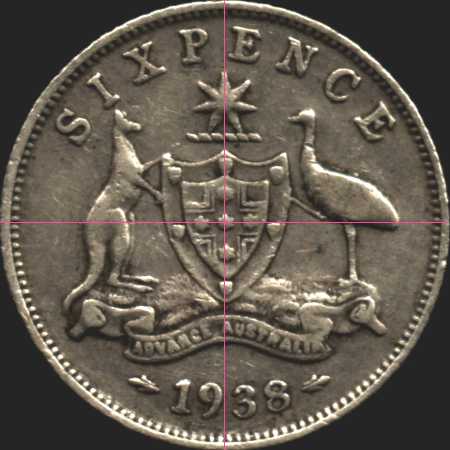
Coins struck in Melbourne, Sydney, Denver and San Francisco.
143 rim denticles. Denticle above star. Main design closer to centre line but
slightly to the right.
Reverse C - 1951
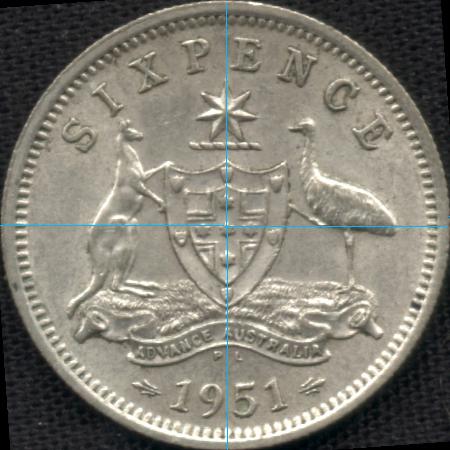
Struck at the Royal Mint in London.
127 rim denticles. Gap above star. Design perfectly centered.
Issuing mints
The early coins of the series were all minted at the Royal Mint in London. From 1916 onwards all sixpences were struck in Melbourne with three exceptions.
In the years 1921 to 1926 inclusive, the Sydney mint shared the job of striking sixpences. There is no way known to distinguish the Melbourne and Sydney mintings by inspecting the coins. (All 1922 sixpences were struck in Sydney.)
During World War II there was an increased demand for coinage and the Australian mints could not handle the workload. In 1942 a substantial portion of the sixpences were struck at the U.S. Mints in San Francisco and Denver and in 1943 and 1944 the entire issue was struck at the U.S. mints.
Finally, in 1951 some twenty million coins out of a total issue of about 34 million were struck by the Royal Mint.
Other Australian coins
Elizabeth II coins (1952-2022)

